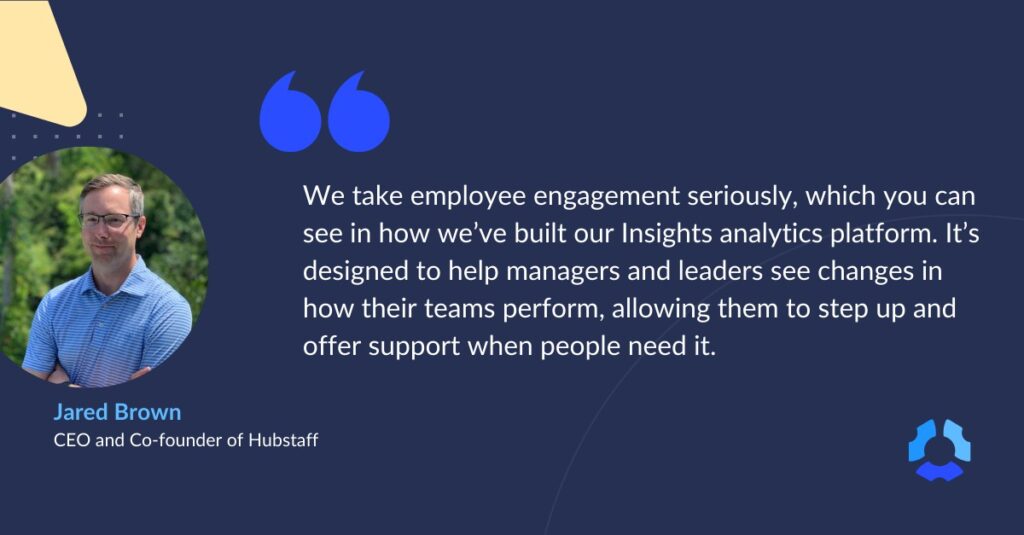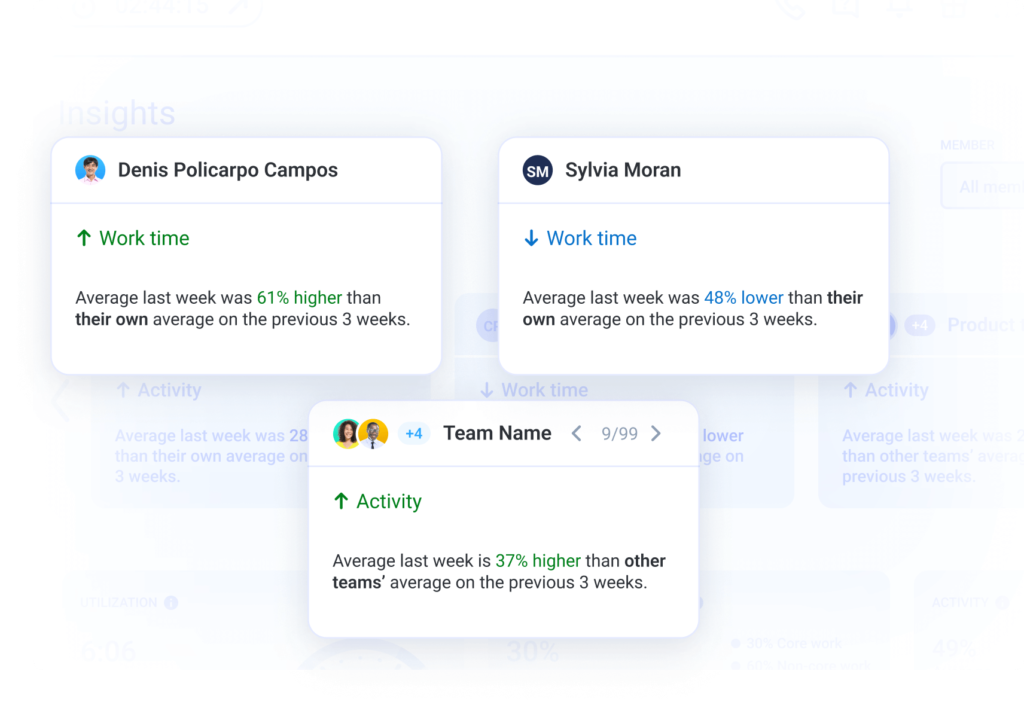Nothing kills productivity like inefficiencies in a company’s internal process, and in no area is this more apparent than in the digital employee experience (DEX). A solid DEX can be the difference between a project getting done in a day and roadblocks and inefficiencies dragging it out for a week.
The benefits of a strong DEX are impressive: increased productivity, higher profits, and improved employee morale. But in a world of growing technology and dispersed workforces, creating a cohesive digital experience for your team isn’t always straightforward.
Without a focus on DEX, employee productivity suffers. A negative DEX can discourage employees and prevent them from completing work quickly. We can’t overstate the importance of getting this piece of your company culture right.
Boost your team’s efficiency with Hubstaff's productivity tools
What is the digital employee experience?
Digital employee experience is employees’ relationship with the software and technology they need to get work done. Their overall sentiment around digital touchpoints is impacted by software quality, the number of tools required to accomplish a task, and the internal IT support they receive.
Digital employee experience is closely tied to employee satisfaction and overall employee experience (EX).
Employee experience is a team member’s overall sentiment, perception, and interactions in their work environment. Building a solid workplace technology experience requires a holistic approach to company culture, technology, communication, and management styles.

Why focus on building your DEX?
Most of us have been victims of an inefficient digital process. It’s frustrating and often prevents us from completing even the simplest tasks. On the other hand, a great digital employee experience can enable clear communication, simplify collaboration, and increase productivity.
Outside of productivity increases and fighting inefficiencies, what makes the digital employee experience important?
- Boosting employee satisfaction: Well-supported teams that are not weighed down by inefficient tools and miscommunication will inherently be happier and more efficient. This is essential because satisfied employees are more likely to stay with your company for the long term.
- Preventing roadblocks: A robust digital culture makes spotting and preventing roadblocks across your organization easier. Integrated technology and automation also reduce the likelihood of teams’ work being delayed and facilitate meeting deadlines.
- Improving internal security: By controlling your digital processes and tools, you can improve your organization’s security, potentially saving money by preventing data breaches and fraud.
Investing in your employees and their experience with digital touchpoints creates a cycle where satisfied employees drive success, increasing profits and productivity.
What can you do to improve your DEX?
From an EX perspective, it is concerning that 67% of employees say “digital experiences in personal life are better than digital experiences at work.”
Let’s look at the best things you can do to improve employee engagement and digital experience.
Communication
What can businesses do to manage digital employee experience? We believe the first and most crucial step is all about communication. There isn’t a one-size-fits-all approach to building a healthy relationship with your team and the digital tools they use. The first step is asking employees what tools they need, how company-mandated software works for them, and using their input to shape your policy. Empower employees to feel comfortable speaking up when digital technology isn’t working so you can fight inefficiency before it impacts productivity.
Technology
When it comes to technology, the key is to get your team involved in the process. A big part of your DEX is ensuring that your team enjoys using the tools in their toolkit. There are also tools specifically designed to improve your team’s DEX.
Here are some tools that can help streamline tasks, improve communication, and boost overall satisfaction for your team:
- Slack: This popular communication platform offers real-time messaging, file sharing, and integrations with numerous apps, fostering seamless collaboration and keeping everyone in the loop, no matter where they are. We use Slack for about 80% of our communication at Hubstaff, and it’s (almost) never let us down.
- Trello: A user-friendly project management tool that uses boards, lists, and cards to organize tasks and projects, Trello helps teams stay organized and ensures that everyone knows what needs to be done and when. Other great options include Monday.com, Asana, and other project management tools.
- Zoom: Essential for remote meetings, Zoom offers high-quality video conferencing, screen sharing, and recording features, making virtual meetings as effective and interactive as in-person ones. You can also consider using tools like Google Meet or Microsoft Teams.
- Hubstaff: You didn’t think we were going to miss the opportunity for a shameless plug, did you? In all seriousness, we use our own software internally as the crux of our DEX. Hubstaff is a comprehensive workforce management tool that not only monitors work hours but also provides insights into productivity. These insights make it easier for managers to allocate resources efficiently and for employees to manage their time effectively.

We’ll admit we’re a bit technology-obsessed at Hubstaff. But we are living proof that by leveraging the right technology, you can create a more efficient, collaborative, and satisfying remote work environment for your team.
Feedback mechanisms
Management should send surveys or set up meetings to discuss tools and get feedback. When you introduce a new tool, check in with your team to see how it works for them. Sometimes, a slight tweak in the workflow or a change in settings is the thing that gets someone on board with a new tool after initial concerns.
Actionable tips to enhance digital employee experience
Are you in a rush and looking for some simple, actionable tips that you can implement immediately to improve your team’s digital workflow? Check these out.
- Implement reliable communication tools like Slack or Microsoft Teams for seamless collaboration.
- Encourage flexible work hours to promote work-life balance and reduce burnout.
- Provide access to wellness resources such as online fitness classes and mental health support.
- Offer professional development stipend for online courses and training programs.
- Send out a survey to gather employee feedback on the tools they currently use.
Now, let’s get a little deeper.
What does DEX look like in practice?
To solidify the value of DEX, let’s step into the real world and examine some examples of a digital employee experience — both positive and negative.
Examples of a positive digital employee experience
Finding a tool that can help you manage your digital employee experience. At Hubstaff, we built features that improve DEX directly into our software, including:
- App usage: See the apps & URLs your team uses broken down into categories — use this to make purchase decisions based on your most-used tools.

- Insights into industry benchmarks: Use the Activity benchmarks add-on to see how this data aligns with other Hubstaff users in your industry. This can help you make sure your team’s productivity is on target.
- Workforce optimization: Hubstaff enables teams to do their best work by allowing managers to view productivity analytics and removing project management barriers.
- Consolidated toolkit: Leadership building a technology stack with consolidated software and integrations. If your team uses multiple tools during their workday, you must set up integrations and automation to transfer their work from one tool to another. Another key is to be aware of the number of tools your team uses and consolidate those tools whenever possible.
Examples of a negative digital employee experience
- Management introduces tools with a steep learning curve without proper training. There are tools out there that are incredibly powerful in the right hands; take a tool like Jira, for example. With the right developer, Jira is versatile and robust. However, Jira is widely known to be a complicated tool to learn and can lead to frustration and roadblocks in the wrong hands.
- Inconsistent communication about security and software usage confuses employee expectations. For example, if you set up the expectation that your team uses a VPN but don’t clarify how and when to use it, this can lead to confusion and prevent the tool from being adopted.
- Employees are not on board with crucial software required to do their jobs. It’s hard to find one tool everyone on your team will love; we all have our preferences. However, you must give your team time to give input and try out a tool before purchasing it for daily use.
Looking forward: The future of DEX
As organizations continue to invest in advanced technologies and prioritize employee-centric approaches, the digital workplace will evolve into a more personalized, collaborative, and supportive environment.
By embracing these changes and finding a digital employee experience solution, companies can ensure that their employees are more productive, engaged, and satisfied with their work. The journey towards an enhanced DEX is about adapting to new tools and reimagining how we work and interact in a digital world.
We’ll leave you with this crucial takeaway: talking to your team is the best way to improve your digital employee experience. Invest in their satisfaction by considering their opinions when building digital processes and getting new tools, and you will almost certainly see increases in productivity and employee engagement.
Most popular
The Fundamentals of Employee Goal Setting
Employee goal setting is crucial for reaching broader business goals, but a lot of us struggle to know where to start. American...
Data-Driven Productivity with Hubstaff Insights: Webinar Recap
In our recent webinar, the product team provided a deep overview of the Hubstaff Insights add-on, a powerful productivity measurem...
The Critical Role of Employee Monitoring and Workplace Security
Why do we need employee monitoring and workplace security? Companies had to adapt fast when the world shifted to remote work...
15 Ways to Use AI in the Workforce
Whether through AI-powered project management, strategic planning, or simply automating simple admin work, we’ve seen a dramatic...




